With an increasing trend in ethical and environmentally conscious investment and the knowledge of both the decreasing supply of fossil fuels and the pollution they exert, the pressure is on and constantly augmenting for greener energy sources. One of the fastest growing energy sources in the world is wind power, gained through the use of wind turbines which is a clean and renewable source.
Unlike other energy plants, turbines can be set up in locations without a water source. Most other energy sources require water for either turning the turbines or for cooling, and in places like California which often suffer from water shortages and drought, this can be problematic.
Wind energy is an endless supply, for as long as we have the sun to heat up the earth there will always be wind. The turbines are cost effective to set up, and can be built on land already being used for farming as they only take up a small amount of space and the rest of the land is left unharmed. This can provide an additional income for landowners.
Wind power is also a very fast growing economy, arguably the fastest in the US. It has the potential to create 600,000 new jobs by 2050 and is expected to grow 108% in the next ten years. It is estimated that by 2030, a quarter of Europe will be powered by wind energy with and estimated €474 billion of cumulative investment in new assets.
Wind power, while decreasing in price, is expensive to initially set up. In areas without much wind it may not prove to be cost effective, and often it may be cheaper to install traditional reactors and power plants. Because a few people don't like to look at the turbines and because most windy areas tend to be far away from the cities, turbines are often set up far from the places which they are powering, which then requires longer electricity lines to be built to accomodate them, although this does revitalise rural economies. Some people also complain about the low ‘hum' sound that some old ones omit but people who understand the clean energy side see the beauty in them.
There is also a level of concern over damage to migrating birds who often use the wind to navigate, although turbines have a lower impact on the environment than most other sources of electricity.
A wind turbine is an intermittent source of electricity as it can only produce power about 30% of the time, and not necessarily when needed.
With more companies looking to trade ethically and an increasing interest in ESG investments, the exigency for wind power the market makes it a very valuable resource. Over the last twenty years, the cost of generating wind power has dropped more than 80%. When turbines were first set up in the 80's, wind power could cost as much as 30c per a kilowatt hour. This has now dropped to as little as 2c. The typical lifespan of a wind farm is 20 years, and there is extensive research on how to extend this even further.

